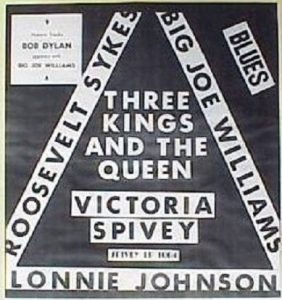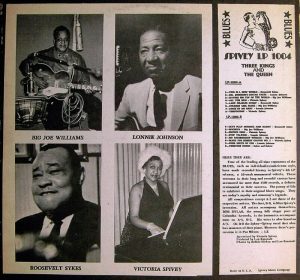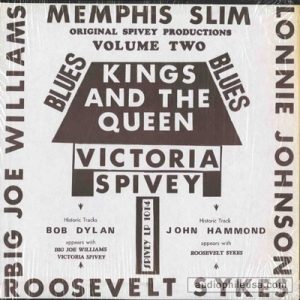By Aaron Galbraith
Dylan’s first recorded and released work was as harmonica player for Harry Belafonte on his version of “Midnight Special” – mentioned recently in part 1 of Jochen’s commentary on “Maggie’s Farm”
This was released on the album “The Midnight Special” in 1962, and has appeared on various Belafonte “best of” collections many times over the years.
An alternative, previously unreleased take 1 was included on the “May Your Song Always Be Sung Again” Dylan tribute album. So here we have Bob Dylan’s first ever performance in a studio environment, June 1961.
Belafonte talks about the incident in his book, My Songs. The original player, Sonny Terry, called in sick to the session, so Dylan was drafted in at the last minute. He turned up with a bag of cheap harmonicas, found the right one, blew it for a few takes, took his $50 and left the studio, tossing the harmonica in the trash on the way out (they were so cheap after you blew them a few times they were useless).
Moving on to Dylan’s second ever appearance on record, again, backing an established singer on harmonica, this time it’s Carolyn Hester. Three tracks appeared on her self titled 1962 album.
Saving the best to last is this version of “Come Back Baby”. Just listen to what Dylan does in the solo, kicking off around the 1:50 mark. He stays on the same note for almost 20 seconds – making it six bars long. You’d have to be brave, foolish or extremely confident in your abilities to attempt something like that in one of your first sessions as a performer. Dylan absolutely nails this one.
(Tony adds: In case you are interested, the band is playing in the key of A, and Dylan’s held note is an E. That is fine for the opening chord, but as the song moves onto the chord of D, the E note that Dylan is holding clashes with the straight D major chord, and makes it sound like the more exciting D9. D9 is a perfectly acceptable chord, although not often used, and it gives the instrumental section more spice, which is helpful since the band is in essence continuing to play the same music as it plays when the vocalist is singing. Dylan’s not the only harmonica player to have done this, and certainly not the first, but he finds a moment to make it work, adding more (the D9) by doing nothing (holding the same note). It certainly works).
 Dylan’s final session as a side man from 1962 was as a harmonica player, and occasionally backing vocals for Big Joe Williams and Victoria Spivey on a series of recordings released in 1962 and a follow up volume in 1972. A picture from these sessions was used on the back cover of New Morning, yes, that’s Bob with Victoria Spivey.
Dylan’s final session as a side man from 1962 was as a harmonica player, and occasionally backing vocals for Big Joe Williams and Victoria Spivey on a series of recordings released in 1962 and a follow up volume in 1972. A picture from these sessions was used on the back cover of New Morning, yes, that’s Bob with Victoria Spivey.
The original album released in 1962 was called “Three Kings And A Queen”, the three Kings being Big Joe Williams, Roosevelt Sykes and Lonnie Johnson with the Queen being Victoria Spivey herself.
The original album released in 1962 was called “Three Kings And A Queen”, the three Kings being Big Joe Williams, Roosevelt Sykes and Lonnie Johnson with the Queen being Victoria Spivey herself.
 The original album released in 1962 was called “Three Kings And A Queen”, the three Kings being Big Joe Williams, Roosevelt Sykes and Lonnie Johnson with the Queen being Victoria Spivey herself.
The original album released in 1962 was called “Three Kings And A Queen”, the three Kings being Big Joe Williams, Roosevelt Sykes and Lonnie Johnson with the Queen being Victoria Spivey herself.
Dylan appears on two tracks with Big Joe Williams, “Sitting On Top Of The World” and “Wichita”. Only the first track is available on line to listen to, and it’s a revelation. Dylan’s performance is amazing and he is even allowed a line or two of vocals on his own.
A second volume from the sessions was released in 1972, called “Kings And The Queen, Volume 2”. Unfortunately nothing is available on line to listen to but the songs with Dylan are “It’s Dangerous” (with Spivey) and the intriguingly titled “Big Joe, Dylan & Victoria”.
If you want to hear those extra Dylan tracks you’ll have to search out original copies of the 2 volumes, they will likely set you back $25-$50 for the first volume and anything up to $100 for volume 2.
Dylan was obviously impressed by Big Joe Williams at that time. He was playing a version of Big Joe’s “Baby Please Don’t Go” in 61/62. It was dropped pretty quickly and strangely he never returned to it again in a live setting.
Untold Dylan: who we are what we do
Untold Dylan is written by people who want to write for Untold Dylan. It is simply a forum for those interested in the work of the most famous, influential and recognised popular musician and poet of our era, to read about, listen to and express their thoughts on, his lyrics and music.
We welcome articles, contributions and ideas from all our readers. Sadly no one gets paid, but if you are published here, your work will be read by a fairly large number of people across the world, ranging from fans to academics. If you have an idea, or a finished piece send it as a Word file to Tony@schools.co.uk with a note saying that it is for publication on Untold Dylan.
We also have a very lively discussion group “Untold Dylan” on Facebook with around 7000 active members. Just type the phrase “Untold Dylan” in, on your Facebook page or follow this link
You’ll find some notes about our latest posts arranged by themes and subjects on the home page of this site. You can also see details of our main sections on this site at the top of this page under the picture. Not every index is complete but I do my best. Tony Attwood


The chronology above is not accurate. The correct sequence was as follows:
> 30 September 1961: Carolyn Hester session (@ Columbia Records, NYC) > 2 February 1962: Harry Belafonte session (@ Webster Hall, NYC) > 2 March 1962: Big Joe Williams session (@ Cue Studios, NYC)
So, the Belafonte session was not Dylan’s first studio excursion.
Also, not one of the above was the first Dylan recording to be issued.
The Belfonte album came out in April 1962, the Hester in May 1962 and “Three Kings And The Queen” not until October 1964.
Dylan’s first Columbia album, released midway through March 1962, preceded all three of three of them into record stores.
We are actively promoting a link to this interesting topic on The Bob Dylan Project at:
https://thebobdylanproject.com/Song/id/5603/Wichita
https://thebobdylanproject.com/Song/id/4507/Midnight-Special
https://thebobdylanproject.com/Song/id/4243/Ill-Fly-Away
https://thebobdylanproject.com/Song/id/4947/Swing-and-Turn-Jubilee
https://thebobdylanproject.com/Song/id/4881/Come-Back-Baby
https://thebobdylanproject.com/Song/id/574/Sittin-on-Top-of-the-World
And every song composed or performed by Bob Dylan
If you are interested, we are a portal to all the great information related to this topic.
Join us inside Bob Dylan Music Box.
All the lyrics resonate with Dylan. That’s not a coincidence.